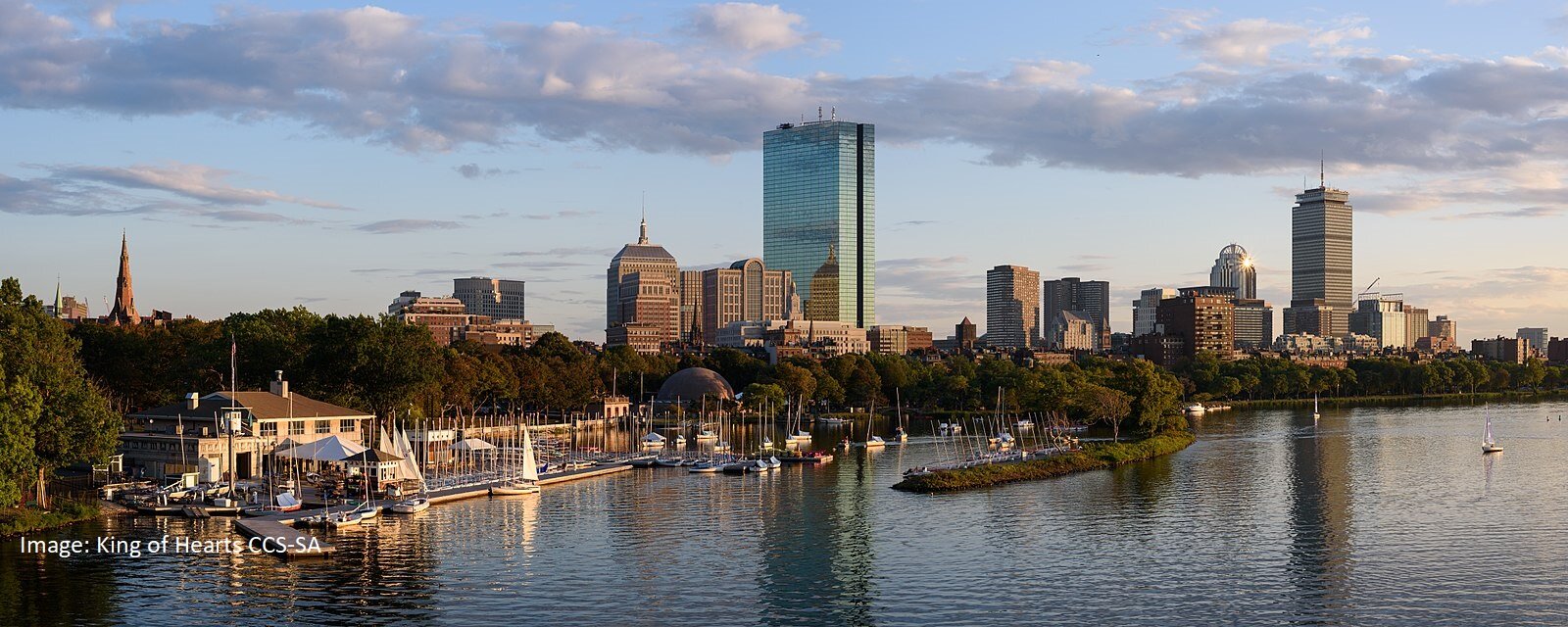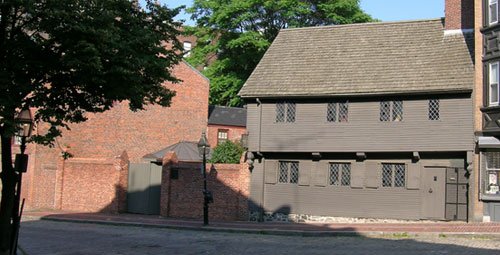
Boston area home-sites of the Revolution
Boston was the largest town in the Thirteen Colonies until Philadelphia outgrew it in the mid-18th century. Boston's oceanfront location made it a lively port, and the city primarily engaged in shipping and fishing during its colonial days. Many of the crucial events of the American Revolution occurred in or near Boston. With economic growth stagnated, and Boston's penchant for mob action along with the colonists' growing lack of faith in either Britain or its Parliament, a revolutionary spirit in the city was fostered. Today you can still visit preserved 17th- and 18th-century home sites from the pre-war era, and related to the American Independence movement in and around Boston.
Fairbanks House c.1637
The pre-revolution Fairbanks House in Dedham, MA is the oldest known timber frame house still standing in North America. Built circa 1637 for Jonathan and Grace Fairbanks and their six children, it was home to eight generations of the Fairbanks family over the course of 268 years. The Fairbanks House is now a historic house museum and on the National Register of Historic Places.
511 East St, Dedham, MA 02026
Image: Magicpiano CC BY-SA
James Blake House 1661
Boston's oldest house, the pre-revolution James Blake House, sits on Dorchester's Columbia Road. The Blake House was built in the manner of the homes of western England, which had long used heavy timber-framing methods, and is one of only a few examples of West England country framing in the United States. The James Blake House is a two-story, central chimney, gable-roof dwelling of timber-frame construction.
735 Columbia Rd, Boston, MA 02125
Image: BPL PD
Paul Revere House c.1680
The Paul Revere House, a medieval-style structure in the North End, is the only 17th century wood dwelling still standing in its original Boston site. Open today as a museum, the well-crafted house displays examples of some of Revere’s metal work – spoons, bowls, dental wiring, bells, engraving plates – as well as late 17th century maps, furniture, and furnishings.
19 N Square, Boston, MA 02113
Image: One Step Forward Foundation
Adams Houses 1681 / 1731
The John Adams birthplace, built in 1681, is a classic New England home of framed construction with two lower and two upper rooms built around a massive central chimney. The John Quincy Adams birthplace is of similar New England framed construction. The two birthplaces are commonly referred to as "saltboxes" because of their resemblance to slant-lid boxes found in colonial kitchens in which salt was stored.
Visitor center: 1250 Hancock St. Quincy, MA 02169
Image: Daderot CC BY-SA
Pierce House 1683
Pierce House is one of the last surviving examples of seventeenth-century architecture in the city of Boston. Lived in by ten generations of one family, the house documents the building practices and tastes of the Pierces over three centuries. Col. Samuel Pierce participated in the fortification of Dorchester Heights. The Pierce family’s story highlights key aspects of social, local, and New England history.
24 Oakton Ave. Boston, MA 02122
Image: jameslwoodward CC BY-SA
Wadsworth House 1726
Wadsworth House was the Harvard presidential home until 1849, and was a site of enslavement for Titus, Venus, Juba, and Bilhah, in the colonial households of Harvard presidents.
For two-weeks starting 2 July 1775, Wadsworth House was home to Gen. George Washington when he first arrived in Cambridge to take command of the Continental Army during the Siege of Boston, before he moved into the nearby Vassall estate on 15 July 1775. On 9 July 1775, Washington convened the first Council of War, and they are believed to have held their meeting in Wadsworth House.
1341 Massachusetts Ave, Cambridge, MA 02138
Image: NPS, Kate Hanson Plass PD
Shirley-Eustis House 1747
The Shirley-Eustis House, a grand example of English Palladian design, was built in bucolic Roxbury in 1747 by William Shirley as his seasonal country estate. Shirley was Royal Governor of the Province of Massachusetts Bay from 1741-1749 and 1753-1756. In 1756 he was also appointed by King George II Commander-in-Chief of all British and Colonial Forces in North America. Shirley and his family lived very public lives as representatives of the British Empire.
33 Shirley St, Roxbury, MA 02119
Image: Avala CCA-SA
Dillaway-Thomas House c.1750
The Dillaway-Thomas House is one of the oldest structures in the Roxbury neighborhood of Boston. Built as a parsonage, this building served as the headquarters for General John Thomas of the Continental Army in 1775 during the Siege of Boston. The house provided views from Charlestown and Bunker Hill to Boston Neck. The house is now a museum with exhibits of Roxbury's past and present history.
183 Roxbury St, Boston, MA 02119
Image: Grk1011 CCA-SA
Vassall-Longfellow House 1759
This home was built by loyalist John Vassall Jr. in 1759. The Vassall family fled to Halifax after the Powder Alarm of 1774. The house served as headquarters for General George Washington during the Siege of Boston, July 1775-April 1776. Later the house was occupied by Henry W. Longfellow, one of the world’s foremost 19th century poets, and author of “Paul Revere’s Ride”. In addition to its rich history, the site offers unique opportunities to explore 19th century literature and arts.
105 Brattle St, Cambridge, MA 02138
Image: Daderot CC BY-SA
Loring-Greenough House 1760
The history of the Loring Greenough House begins in 1760 when Joshua Loring, a commodore in the English Colonial naval forces, constructed the large four-square Georgian Colonial frame residence in the historic center of Jamaica Plain. The House was the hub of an active farm that was Loring’s chief interest following his military retirement. His life as a distinguished member of the Colonial gentry came to an abrupt end with the incipient Revolution. He relocated to Boston in 1774, and permanently left Boston for England in 1776.
12 South St, Jamaica Plain, MA 02130
Image: Biruitorul PD
Hancock House 1767
The Ebenezer Hancock house, was built in 1767. In 1660, this was the site of the home of William Courser, first Town Crier of Boston, and in 1737 was the home of James Davenport, Brother-in-law of Benjamin Franklin. John Hancock built and owned the house, but it was occupied by his brother Ebenezer, who served as Deputy Paymaster General of the Continental Army. In 1779 the home housed two million silver crowns loaned from Louis XVI of France to the new government,
The oldest continuously operated shoe store occupied the first floor from 1798 until 1963. The home was purchased for restoration in 1976, has been designated a National Historic Landmark, and is occupied by Swartz & Swartz, Attorneys.
10 Marshall St, Boston, MA 02108
The Hancock house is currently for sale: Details
Image: Lundy PD
Otis House 1796
There are three houses named the Harrison Gray Otis House in Boston, Massachusetts. All were built by noted American architect Charles Bulfinch for the same man, Federalist lawyer and politician Harrison Gray Otis. The first Otis house, built in 1796, is located at 141 Cambridge Street, next to the Old West Church in Boston's West End. It is now a National Historic Landmark, and a historic house museum owned and operated by Historic New England, which uses part of it as its administrative headquarters.
141 Cambridge St, Boston, MA 02114
Image: Daderot CCA-SA











